National Aeronautics and Space Administration
Goddard Space Flight Center
Search:

Balloon Program Office
Super Pressure Balloon
Development Goals
The goals for the development of the NASA Super Pressure Balloon (SPB) are related to supporting a specific science mass to a set stable altitude for an extended duration. The program level requirements are as follows:
- The SPB shall be capable of supporting 1 ton of science instruments
- The SPB shall be capable of sustained flight altitude of 110,000+ ft (33.53+ km).
- The SPB shall be capable of sustained flight with an allowable altitude variation of plus (+) infinity and minus (-) 5,000 ft (1,524 m) for normal operations. Rare extreme low temperature events shall allow an occasional dip to lower altitudes.
- The SPB shall be capable of sustained flight duration of up to 100 days.
- The SPB function and performance shall be independent of science mission type.
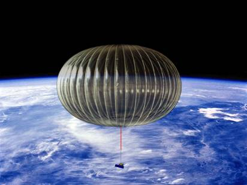
The Super Pressure Balloon is designed to be flown at any latitude on the globe regardless of day night cycles including mid-latitude flights. It is intended that this new vehicle will provide a new capability to the science community.
Super Pressure Balloon Design Approach
A balloon that always maintains a positive internal pressure in relationship to the environment it is floating in is called a Super Pressure Balloon. The NASA Super Pressure Balloon is a sealed structure that is filled with a measured and specific amount of Helium lifting gas. The balloon rises after launch, and the Helium expands as the ambient atmospheric pressure goes down. The NASA Super Pressure Balloon is designed to fly at a specific pressure altitude with a known mass of payload hanging from the balloon.
When the balloon reaches the desired float altitude, the extra Helium is not vented off, but fills out the shape and pressurizes the balloon. The amount of Helium first put into the balloon is determined by how much is needed to lift the entire flight system plus some extra Helium to provide an upward force. This extra Helium is enough to pressurize the balloon when it reaches the float altitude, but too much to over pressurize the balloon. The Super Pressure Balloon is designed to fly with a positive internal pressure at all times. When the sun heats the balloon during the day it has a higher internal pressure (also called differential pressure since this represents the pressure difference above the atmospheric pressure it is flying in), and at night when the balloon cools down, the differential pressure is much lower, but still above ambient. The differential pressure range of the NASA Super Pressure Balloon is up to 180 Pa (0.0261 psi). This is a very small internal pressure, but it is enough to keep this balloon flying through the night!
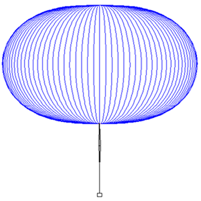
Depiction of the shape of a Super Pressure Balloon from the side at float
The overall shape of the NASA Super Pressure Balloon is an oblate spheroid (like a sphere only squashed on the top and bottom). The height is about 60% of the diameter. The NASA Super Pressure Balloon is made up of many separate panels or gores that run from top to bottom on the balloon. At the edge of each of these gores is a very strong and light weight tendon or rope that runs from top to bottom on the balloon. Each of these gores are shaped that, while under pressure, have a slightly curved lobed shape. This is why this type of balloon has been called a pumpkin shaped Super Pressure Balloon.
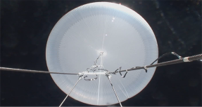
Up looking view of the Super Pressure Balloon at float
Even with very small internal pressures, because of the size of the balloon, the forces are quite large. The strength required for the film materials is a function of the internal pressure times the radius divided by the film thickness (Pr/t or Pressure times the radius divided by the film thickness). If the balloon was spherical in shape, this very large radius would lead to a very high strength requirement for the film. High strength requirements often require stronger materials which are often heavier. The films used for the NASA balloons are very thin and light weight.
The Super Pressure Balloon is basically made up of two elements; very thin film and the tendons that run top to bottom. There are two methods NASA chose to reduce these very high strength requirements. The first was to make each of the gore sections slightly lobed and reducing the local radius of the film. This reduced the radius on the film from over 50 m to around 1 m. Reduced radius translates to reduced strength requirements in the horizontal or �hoop� direction for the film. Second, the tendons that run top to bottom in the balloon are used to resolve the forces in that direction. Each tendon can have approximately 7,000 N (~1,600 lbs) per tendon, which means the fittings on the top and bottom of the balloon must resolve a total force of ~1,960,000 N (~448,000 lbs) for the 280 tendons that are used in the balloon.
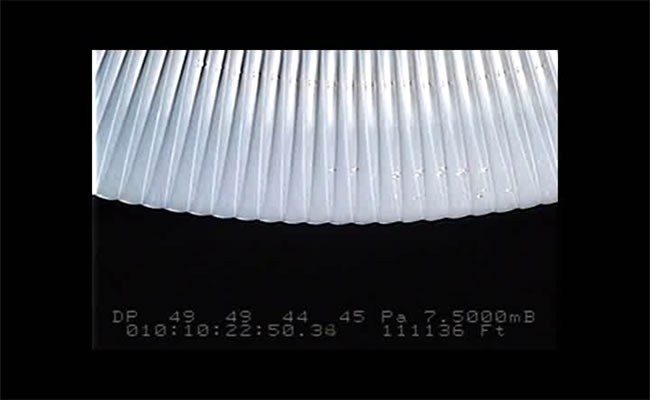 |
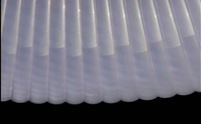 |
Advanced Support Systems
CSBF Flight Systems- Longer flights require systems with higher reliability
- Unique systems for these longer flights are also required
- The long duration Super Pressure flight systems are similar to those provided for the NASA LDB missions
- CSBF has developed new systems as well as new unique systems for the long duration Super Pressure Balloon flights
- Reliable solar power and charging systems for long flights
- Flight control and data storage including redundant flight computers for telemetry, ballast, and terminate
- Communication systems for line of sight as well as long duration flight
- Other flight systems to support unique needs for Super Pressure Balloon flights including differential pressure measurement, environment measurements, tendon loads and more
- Camera systems � smaller, lighter weight, fixed focal length, pan/tilt/zoom systems, and systems to obtain images from over the horizon on very long flights
- Balloon, launch & recovery services, payload development support
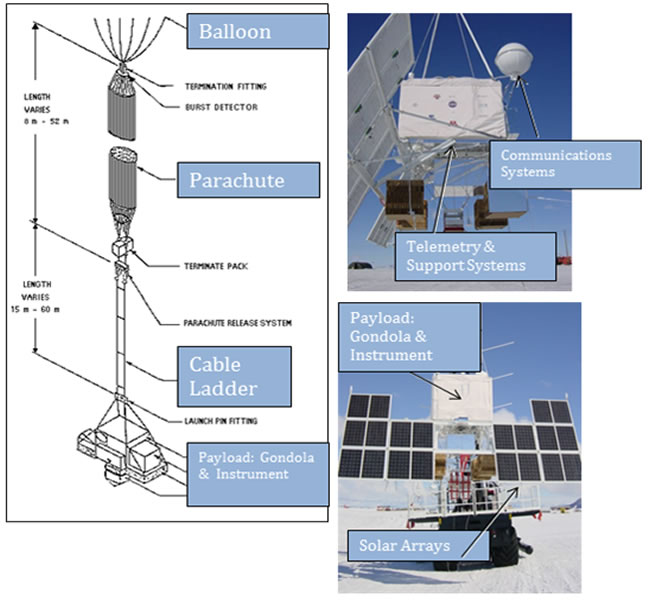 |
Wallops Arc Second Pointer (WASP)
- WASP is an Enabling Technology Development
- Enabling Precision Balloon Science Observations
- Solar Imaging
- Exo-Planet Finding
- Other Science Where High Precision Pointing is Required
- Successful Ground Test Results
- Ground Tests with Mock Telescope
- 24 foot long, 1500 lbs.
- Pitch and Yaw Torque Motors
- Sub-Arcsecond Pointing Achieved
- Jitter less than 0.75 arcseconds RMS
- Flight Prototype Design
- Full Scale Gimbal (1 meter spacing)
- 1200 lbs. mock telescope
- New Flight Processor, Software, Motor Drivers
- Fiber Optic Gyroscope
- Test Flights Fall 2011, Fall 2012, and planned for Fall of 2013
Flight Trajectory Control
- The potential for flight trajectory control will be an enabling technology for long Super Pressure Balloon flights
- Typically a balloon floats along with the prevailing winds for the length of its flight
- The goal of trajectory control is to slightly modify the balloon flight track over time to be able to steer the system to preferred flight latitudes
- This would allow a balloon to be launch from one location and then to be shifted to a latitude band where there will be little population or land to overfly during the mission. Toward the end of the mission, the balloon would be steered back to a desire location to safely terminate the flight and recover the science instrument.
- Flight Trajectory Control is a long term advanced support system desired by the NASA Balloon Program Office
Super Pressure Balloon Test Flights
There have been a number of test flights of the NASA Super Pressure Balloon to explore the design, deployment of this type of structure, and flight duration. These test flights have positively worked toward improving the balloon fabrication approaches through new and innovative production processes. Advancements in the launch operations techniques have also been achieved.
The project approach has focused on incremental steps up in balloon volume and payload carrying capability. There are always challenges with both production and launch operations as a balloon goes up in size. The incremental stepwise approach to building bigger balloons was adopted to try to effectively manage these challenges and provide continuity for the process. Balloon volumes have steadily increased over time. Coupled with the increased balloon volume are increases in the number of gores in the balloon and the payload carrying capability. Below is a list of the balloon designs flown using the current design approach as part of this incremental development process.
- ~56,800 m3 (~2,006,000 ft3), 200 Gores, ~295 kg (~650 lbs) suspended payload
- ~200,000 m3 (~7,000,000 ft3), 200 Gores, ~680 kg (~1,500 lbs) suspended payload
- ~422,400 m3 (~14,900,000 ft3), 230 Gores, ~1,800 kg (~4,000 lbs) suspended payload
- ~532,000 m3 (~18,800,000 ft3), 280 Gores, ~2,270 kg (~5,000 lbs) suspended payload
NASA Code 820
Scientific Balloon Update
Report back for the latest update from NASA's Balloon Program Office.
- NASA Official: Debora Fairbrother
- Point of Contact: Valerie Brizak
